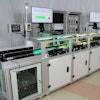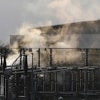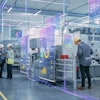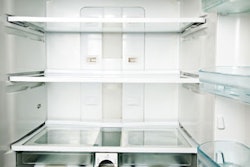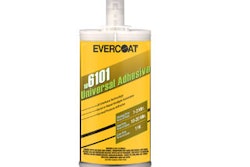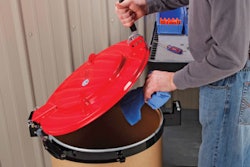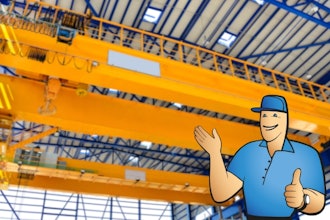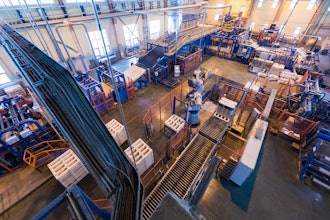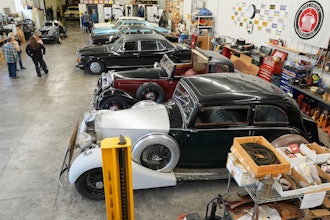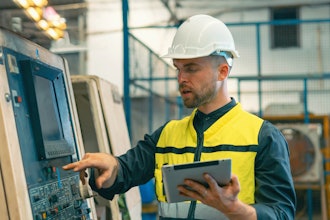The ability to safely move large, heavy loads is an integral part of industrial manufacturing. When these loads cannot be moved manually, hoists and lifts can be utilized to transfer materials to a new location. When using these tools, there are significant safety issues to be considered, for the operator, the device, and nearby workers. IMPO sat down with three industry experts to discuss key safety and training issues, and to see what’s new in lifting technology.
Tom Golling, Jergens, Inc.
Tim Golling has 42 years of experience with Jergens Inc., which is comprised of three distinct units: workholding solutions, lifting, and specialty fasteners. He specializes in lifting and rigging below-the-hook hardware.
IMPO: What are the key elements to hoist and lift safety?
Golling: Companies must establish, document, and strictly adhere to a preventive maintenance program. The safety department, supervisors, and operators all share responsibility for the effective implementation of a preventive maintenance program. Next is an annual or semi-annual inspection of all lifting-related equipment, including cranes, chains, slings, and all below-the-hook hardware. Finally, strict enforcement of written procedures and proper use of all lifting equipment—as the old saying goes, “Someone loses a hand, everybody gets religion.”
IMPO: How focused is the average industrial manufacturer on hoist and lift safety?
Golling: I believe that most manufacturers do believe in—and attempt to practice—good safety practices. Safety glasses, face protection, gloves, hardhats, and protective clothing are the norm, and considerable effort is typically made with regards to employee protection. When it comes to lifting and handling heavy objects, however, my sense is that the there is a lesser degree of education and implementation concerning safety practices. Top management and safety/HR employees understand the need for lifting safety, but the person who is actually making the lift often may not have the training, knowledge, or proper equipment to make the lift safely. Ongoing education is absolutely mandatory.
IMPO: Despite the number of regulations and guidelines that apply to lifting, incidents continue to occur. What are some safety practices you would recommend to an industrial manufacturer? Where do most manufacturers go wrong in their approach to safe practices?
Golling: Although it may take an incident to bring things to light, we find that many manufacturers have no idea as to who the manufacturer/supplier is of the hardware, chain, and web slings they use. Additionally, many don’t keep a record of the date these items were put into service. Proper marking of the hardware and record-keeping may save many hours of research should an incident occur. The user needs to know who he or she should contact in the event of a problem.
We understand that every end user is trying to get the best pricing they can on all of their purchased hardware. When it comes to lifting-related items, however, you truly do get what you pay for. My advice to manufacturers is never to skimp on quality and service because the cheapest isn’t always the best.
IMPO: What new technologies have advanced hoist and lift safety in recent years?
Golling: New products come on the market on a regular basis, and manufacturers need to make a concerted effort to become aware of those devices.
Probably one of the most valuable technologies that has emerged in recent years is RFID (Radio Frequency Identification), which uses a chip or small disc containing information on a given product. A simple chip scan reveals the date of manufacture, initial inspections, certifications, etc., along with an ongoing history of inspections, replacement parts, and rebuilds. Many manufacturers include this technology or offer it as an option with their products. Although RFID is still in its infancy, the concept has caught on as a universal method of tracking the “cradle to grave” history of a given product.
IMPO: Any other tips for manufacturers working with hoist and lift equipment?
Golling: Some keywords I would suggest manufacturers keep in mind include:
- Ongoing education
- Regular inspections
- New technologies
- Mandatory safety training sessions
Mark Grandusky, Gorbel
Mark Grandusky is the sales manager for intelligent lifting devices with Gorbel, which provides a variety of overhead handling solutions that handle loads from 50 pounds to 40 tons.
IMPO: What are the key elements to hoist and lift safety?
Grandusky: Making sure the operators have the proper training for the lifting device they are using, a good preventive maintenance program, and selection of the proper and most ergonomic lifting device to fit the application. An operator not only needs to know how to use the lifting device but how to use it safely. There are risks associated with using a lifting device and the operator needs to understand those risks. For example, an air balancer is traditionally a cost effective way to lift loads quickly, but there is a significant risk of recoil if the load comes loose from hook or end effector and can seriously injure the operator.
Preventive maintenance is critical to ensure the lifting device is in safe working order. Selection of a reputable lifting device inspection and repair organization can be a great help with this.
Selecting a lifting device that ergonomically fits the application is important to prevent repetitive strain injuries. As an example, if a bulky free-standing manipulator is installed to lift and move a relatively light load quickly, with a high number of lifts per hour, chances are good the operator will incur a repetitive stress trauma injury. Selecting a lightweight lifting device and support structure with minimal mass to move would be a more appropriate choice.
IMPO: How focused is the average industrial manufacturer on hoist and lift safety?
Grandusky: I think most companies are concerned and focused on safety to some degree but some are safer than others. In my experience, those companies who are dedicated to ongoing safety training, procedures, policies, and have dedicated safety resources that go beyond the standard safety requirements seem to have the safest working environments. Also those companies that encourage every employee to actively and openly engage in making sure the work environment is safe, take yet another step toward increased safety.
IMPO: Despite the number of regulations and guidelines that apply to lifting, incidents continue to occur. What are some safety practices you would recommend to an industrial manufacturer? Where do most manufacturers go wrong in their approach to safe practices?
Grandusky: Safety policies and procedures are only as good as those executing them. I believe most companies start out with the a passion for safety but over time that passion can sometimes turn into more of a necessary daily routine to make sure all the boxes are checked off on the safety list. Continuous safety education and incentive programs that keep safety top of mind and keep the entire organization passionately engaged will help ensure safety doesn’t turn into just a list of mundane tasks.
IMPO: What new technologies have advanced hoist and lift safety in recent years?
Grandusky: The all electric, servo-powered Intelligent Lifting Devices (ILDs), such as Gorbel’s G-Force® ILD Product Line, are one of the most exciting advancements in lifting in the past decade and offer a wide range of safety enhancements over traditional lifting devices such as chain hoists, air balancers, and manipulators. These benefits include:
Operator Presence Sensing technology, which ensures the lifting device will not operate unless the operator is fully engaged with the hand controller.
A fail safe motor brake, which stops the load immediately if a fault or power outage occurs.
Electronic overload sensing, which instantly stops any load over the units rated capacity from being lifted.
Anti-recoil technology, ensuring G-Force® ILDs will never recoil under a lost load condition.
IMPO: Any other tips for manufacturers working with hoist and lift equipment?
Grandusky: In my experience, the most successful introduction of a lifting device includes the operators in the decision-making process. A lifting device is only going to provide a safety and ergonomic benefit if the operator actually uses the lifting device. Ensuring the operator is involved in selecting the best user friendly device for their needs will go a long way toward future safety.
Mike Adel, AutoQuip
Mike Adel is the director of engineering with AutoQuip, a leader in the material handling industry that offers a variety of heavy equipment manufacturing solutions.
IMPO: What are the key elements to hoist and lift safety?
Adel: First, select the right tool for the job. If all critical application requirements are not known or understood, there is the potential for a lift design to be selected that is not completely appropriate or safe. If the lifting equipment is not what the end user expected or needed, field modifications may be made to the equipment without consulting the factory or supplier of the lift—jeopardizing safety.
Second, there is no substitute for good training. The operators of industrial lifts should be provided with adequate and regular training as to the safe operation of the equipment, and be given access to the operations manual for future reference. Maintenance personnel should also be given adequate and regular training
Third, use common sense—and your other senses. If something doesn’t sound right, stop running the lift and check it out. If you see premature wear, ask for maintenance. If the safety warning labels on the lift are worn or damaged, ask for new ones. If you are asked to crawl beneath a lift for repairs, stop and ask to see the manual.
IMPO: How focused is the average industrial manufacturer on hoist and lift safety?
Adel: Manufactures focus on overall worker safety and provide safety programs that center around topics that affect the majority of their employees: fire safety, ear/eye/toe protection, traffic safety, etc. Manufactures should also focus training surrounding smaller work groups who operate and maintain lifts on a regular basis providing routine safe operation and maintenance demonstrations. This training is critical to preventing accidents.
IMPO: Despite the number of regulations and guidelines that apply to lifting, incidents continue to occur. What are some safety practices you would recommend to an industrial manufacturer? Where do most manufacturers go wrong in their approach to safe practices?
Adel: Many manufacturers assume that because the lift is fairly simple and straightforward in how it operates, there is no real danger. However, as with the operation of any heavy piece of equipment, there are always best practices in the safe operation and maintenance of these lifts, and many inherent dangers if these best practices are ignored. The employees that are most commonly injured when working around industrial lifts are the maintenance employees. The combination of the most dangerous work (reaching into the lift mechanism or even working under the lift itself) being performed by the employees that are the least familiar with the lift and how it works and operates leads to the highest occurrence of injuries. Add to that fact that maintenance and operating personnel rarely get to see, much less get trained on, using the lift's manual.
IMPO: What new technologies have advanced hoist and lift safety in recent years?
Adel: Autoquip Corporation has been applying Human-Machine Interface (HMI) technologies to our lifts as an option, which provides additional operator safety through the conversion of manual tasks to automated tasks via PLC programming. Plus, added sensors, photo eyes, and other such peripheral safety devices can be incorporated into the lifting solution. The most effective safety devices are often the simplest, and nothing replaces a good operator training program.
IMPO: Any other tips for manufacturers working with hoist and lift equipment?
Adel: Autoquip recommends working closely with the lift vendor and/or supplier, to bring them in early during the project definition stage to help develop the most effective and safe lifting solution for that particular application. There are many application-specific issues that will be recognized and addressed by the supplier that the owner/user of the equipment simply may not recognize, such as special design requirements for riders on the lift, pit mounting of the lift, or attaching things to the platform.


